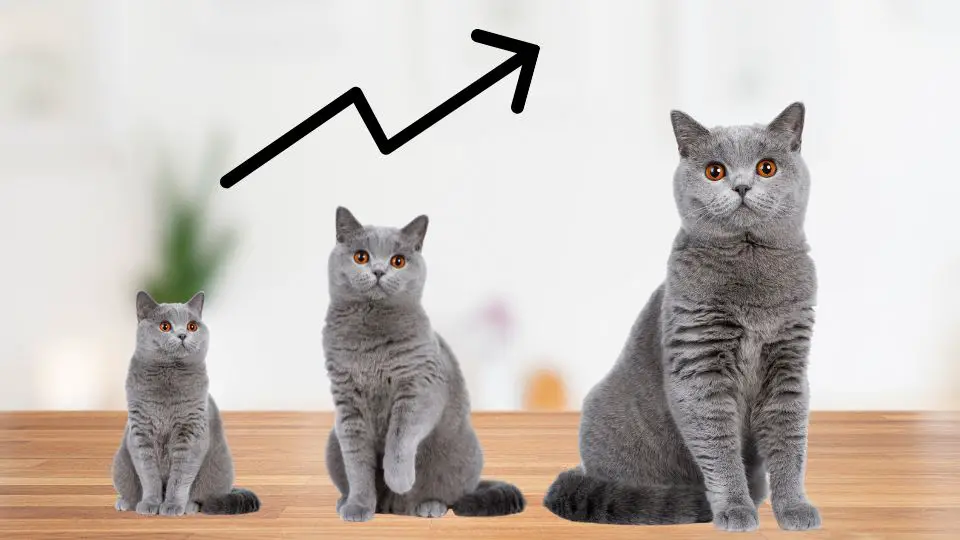Are you a proud owner of a British Shorthair and wondering how long their pregnancy will last?
Well, the gestation period for this beloved breed usually lasts for about 63-68 days, which is the average length of pregnancy for cats.
However, there are several factors that can affect the length of pregnancy, including the health and age of the mother, so it’s always best to consult with a veterinarian for the most accurate estimate.
Gestation Period of British Shorthair Cats
The gestation period of British Shorthair cats typically lasts for 65 days, but it can go around 63-68 days, which is the same for most domestic cats.
During pregnancy, British Shorthair cats will experience a range of physical and behavioral changes. Some of the most common changes include increased appetite, weight gain, and nesting behaviors. As the pregnancy progresses, the mother cat’s nipples will also become more prominent and may produce milk.
Prenatal care for pregnant British Shorthairs
Prenatal care is essential to ensure the health of both the mother and the kittens. This care includes providing a nutritious diet, ensuring the mother has access to clean water at all times, and regular veterinary check-ups. Here are some tips for prenatal care of pregnant British Shorthair cats:
- Proper Nutrition: During pregnancy, the cat’s nutritional needs will change, and it is important to feed them a high-quality diet that is rich in protein and essential nutrients like calcium, vitamins, and minerals. Consult with a veterinarian to determine the proper diet for your pregnant British Shorthair.
- Regular Veterinary Visits: Regular visits to a veterinarian are important to ensure that your cat is healthy throughout pregnancy. The veterinarian will monitor your cat’s health and provide recommendations for proper care.
- Keep Your Cat Comfortable: During pregnancy, it is important to keep your cat comfortable by providing a clean, warm, and quiet environment. Make sure your cat has a comfortable bed, and provide extra blankets and pillows for added comfort.
- Exercise: Regular exercise is important for pregnant cats. Encourage your cat to stay active by providing toys and interactive playtime. However, do not over-exercise your cat, as this can cause stress and harm to the developing kittens.
- Watch for Signs of Complications: Keep an eye out for any signs of complications, such as lack of appetite, lethargy, or discharge. If you notice any of these symptoms, contact your veterinarian immediately.
- Prepare for Delivery: Make sure you are prepared for the delivery by having a birthing area ready and supplies on hand. Talk to your veterinarian for guidance on what supplies you will need and how to prepare for the delivery.
Is it normal for a cat to be 67 days pregnant?
Yes, it is normal for a cat to be 67 days pregnant. However, if the cat has not given birth after 67 days, it is recommended to consult a veterinarian as there could be complications. Additionally, it is important to monitor the cat’s health and behavior during the pregnancy to ensure a healthy delivery.
Stages of British Shorthair Pregnancy
The gestation period of British Shorthair is divided into three distinct stages.
Stage 1
During the first stage of British Shorthair pregnancy, the cervix and uterus begin to relax in preparation for giving birth. The uterus also gently contracts, which pushes the kittens down towards the birth canal. This stage can last for 12-36 hours and the signs of labor may be subtle.
One of the first signs of labor is the loss of the mucus plug, which is a small amount of discharge that marks the beginning of stage one of labor. The discharge may be green or pinkish in color and is usually around the size of a two pence piece. Once the mucus plug has been lost, the first kitten will usually arrive within 24-48 hours, but it can vary and a maiden queen may take longer.
As an owner, you should look for signs of restlessness, nesting behavior, and more frequent grooming than usual. You may also notice your cat being more affectionate than usual or having a loose stool. Some cats may stop eating or eat much less than usual, but not all cats exhibit this behavior.
Provide your cat with a quiet and comfortable space to rest and give birth. It’s also a good idea to have a clean and warm nest box with soft bedding ready for when the kittens arrive. Keep the area clean and make sure your cat has easy access to food and water.
Note that not every cat will exhibit all or any of these signs. However, if your cat has lost her mucus plug and there are no kittens born more than 48 hours later, you should contact a veterinarian. This is because the mucus plug plays a vital role in preventing bacteria from entering through the cervix, and if it’s lost and the pregnancy continues for an extended period of time, it can be a risk to the health of the pregnancy.
Stage 2
The second and third stages tend to happen together, with stage 2 being the birth of the kittens and stage 3 being when the placentas are passed.
The uterus contracts much more strongly during stage 2 and pushes the kittens out, usually with the protective mucus membrane still intact. The kittens can come out headfirst or feet first, and the queen will lick them clean, remove the membrane and bite through the umbilical cord.
Each kitten takes between 5 and 30 minutes to deliver, and if the cat is actively straining for more than 30 minutes and no kitten appears, it’s important to contact a veterinarian.
Stage 3
Stage 3 involves passing the placentas. Each placenta is usually passed after each kitten is born, but sometimes two or more kittens can be born before the placentas are passed. Remember to count the placentas as they come out to ensure there are the same number as there are kittens. If a placenta is left inside a cat, it can cause serious health issues and needs a vet trip.
Also, note that twins may share a placenta.
Preparing for the Arrival of British Shorthair Kittens
Preparing for the arrival of British Shorthair kittens can be an exciting and nerve-wracking time for any cat owner. Make sure you are fully prepared to provide the best possible care for the mother and her newborn kittens.
The birthing environment should be comfortable, warm, and quiet to help the mother feel at ease. A box or nesting bed lined with blankets or towels will provide a safe and comfortable space for the mother and her kittens. Keep the nesting area away from high-traffic areas and other pets to minimize stress for the mother.
Planning for the care of newborn kittens
Newborn kittens require around-the-clock care in the first few weeks of life. You will need to have the appropriate supplies on hand, such as kitten formula, bottles, and a heating pad. Make sure to keep the nesting area clean and free of any potential hazards.
Potential complications during labor and delivery
Complications during labor and delivery are relatively rare in cats, but it is important to be prepared in case something goes wrong. Have the phone number of your vet on hand, as well as an emergency vet clinic in case of after-hours emergencies. Be prepared to take the mother and her kittens to the vet if necessary.
How many kittens do British Shorthairs have?
The number of kittens British Shorthairs have can vary but the average litter size is around 4-6 kittens. However, some litters can have up to 8 kittens, while others may only have 1-2 kittens. It also depends on various factors such as the age and health of the mother cat.
Can you touch newborn kittens?
It is generally recommended to limit handling of newborn kittens for the first few days of their life, until their eyes are still closed, as they are fragile and their immune systems are not yet fully developed.
You should let the mother cat take care of them and keep them warm, clean, and well-fed. It is best to wait until the kittens are at least two weeks old before handling them extensively, and remember that the mother will also let you know how comfortable she is with you handling her babies. If she seems uneasy or distressed, it’s best to back off and give her space.
If you need to handle newborn kittens, it’s important to do so carefully to avoid harming them. Here are some tips:
- Wash your hands thoroughly before handling the kittens to avoid transferring germs or bacteria to them.
- Use a soft, clean cloth or towel to handle the kittens, as your hands may be too rough for their delicate skin.
- Be gentle and move slowly when picking up the kittens. Support their head and hindquarters to avoid injuring their neck or spine.
- Avoid handling the kittens too much or for too long, as they need plenty of rest and should not be separated from their mother for extended periods of time.
- If you notice any abnormalities or signs of illness, such as lethargy or lack of appetite, contact a veterinarian for advice.
Should I remove a dead kitten from the litter?
It can be a difficult decision, but it’s recommended to leave a dead kitten with the mother, so she can be aware of what happened. Once the mother notices, she will often shift her focus to her remaining kittens.
However, if you choose to remove the dead kitten, do so carefully and consider taking it to a veterinarian if you wish to have it cremated.
Conclusion
In conclusion, the gestation period for British Shorthair cats is typically around 63 to 68 days. However, as with any pregnancy, it is important to monitor the cat’s health and behavior throughout all stages of pregnancy. Providing proper prenatal care and preparing for the arrival of the kittens can help ensure a healthy and successful delivery. If any concerns arise during the pregnancy, it is always best to consult with a veterinarian for guidance and support.







